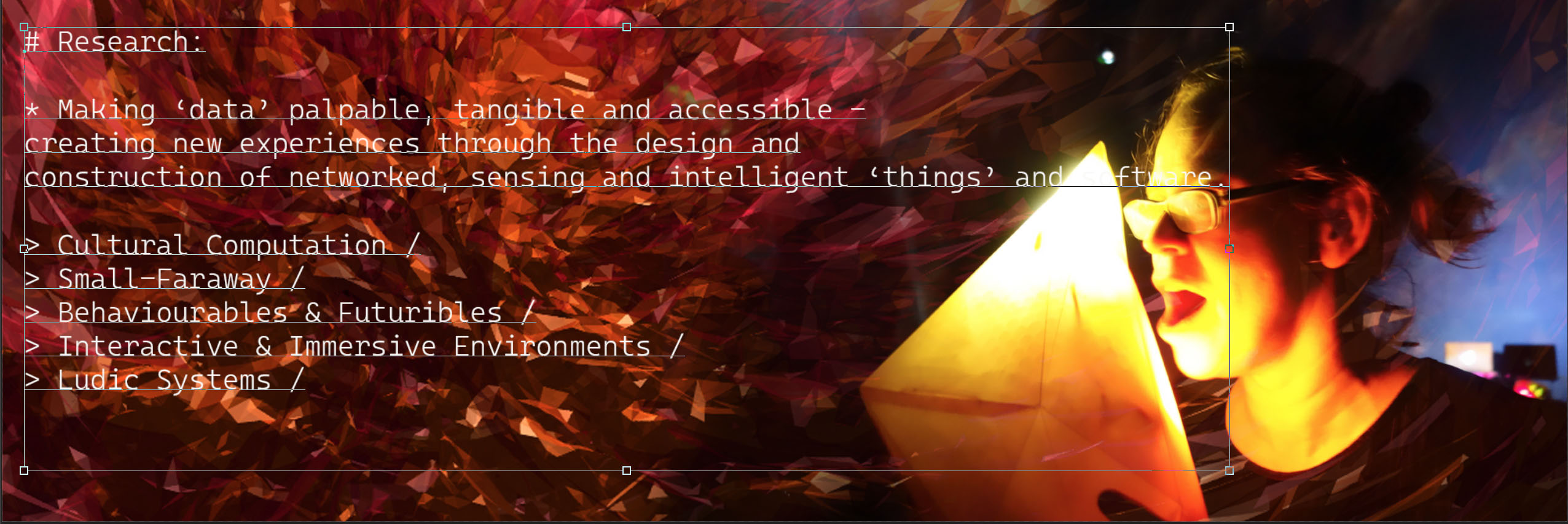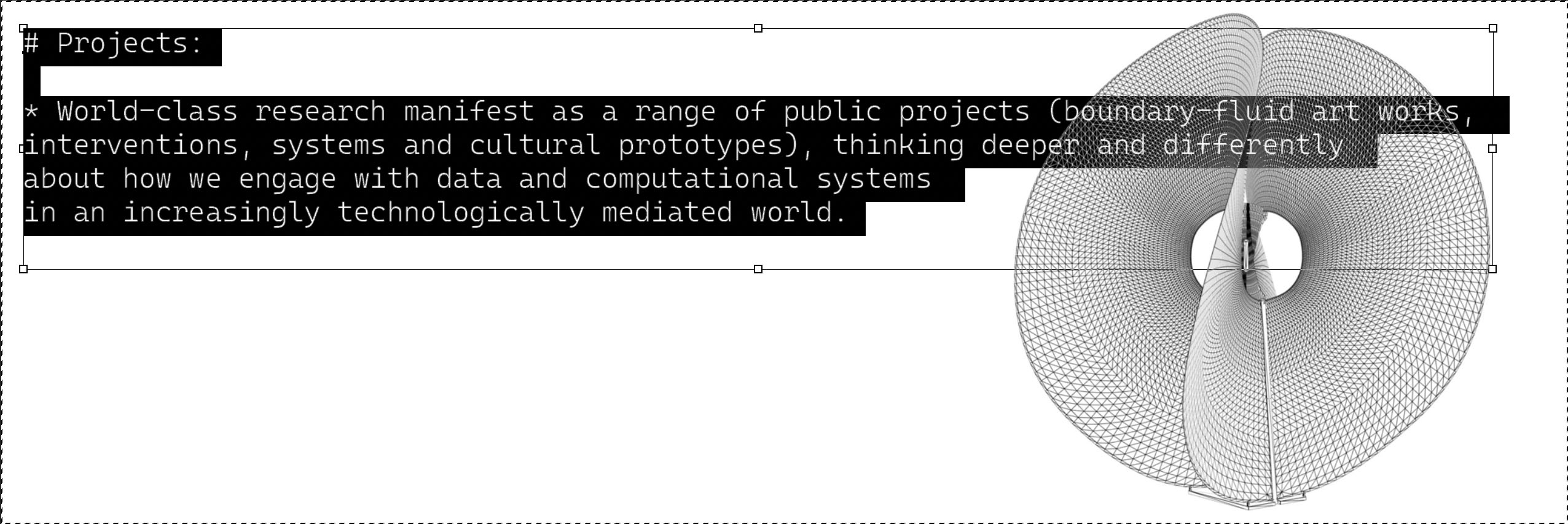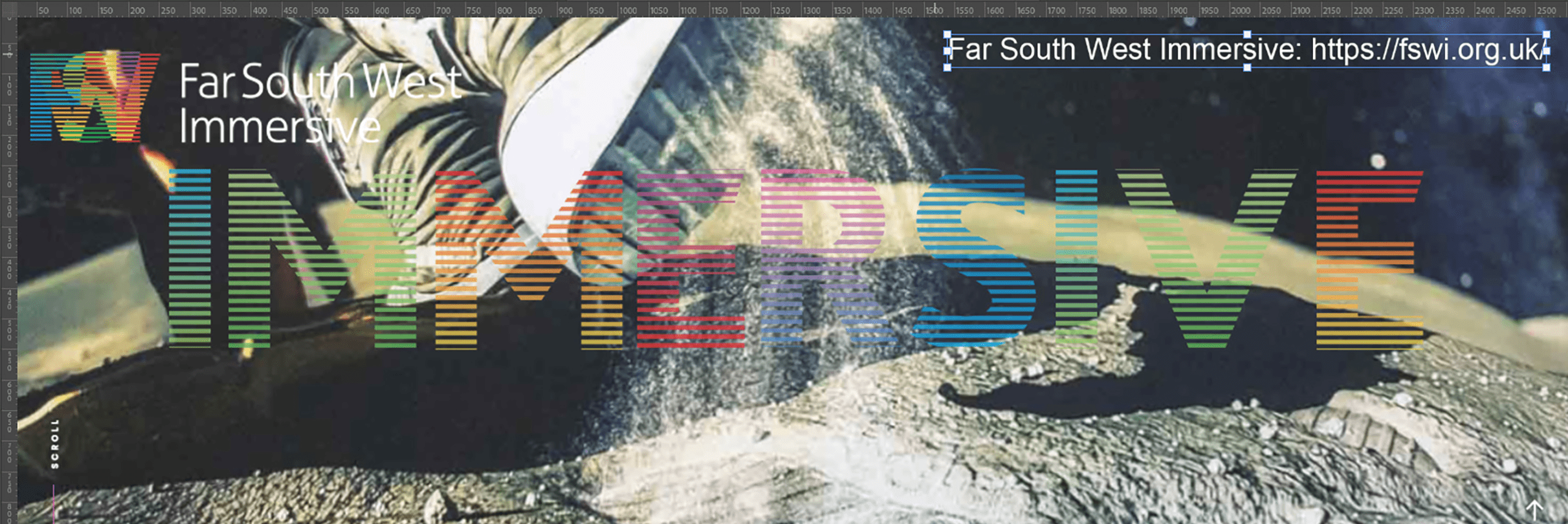i-DAT’s algorythmic heritage flows through the core of our practice and dates back to the early years of our formation in 1998. Some of our creative Artificial Intelligence/Machine Learning project include:
1997: Psalms:

https://i-dat.org/psalms/
Psalms is the Autonomous Wheelchair constructed by Guido Bugmann for Donald Rodney’s “Nine Night in Eldorado” at the South London Gallery, 1997. Now in the Tate Collection.
2000: Autoicon:

https://i-dat.org/autoicon/
Autoicon is a dynamic internet work and CD-ROM that simulates both the physical presence and elements of the creative personality of the artist Donald Rodney who died from sickle-cell anaemia. The project builds on Donald Rodney’s artistic practice in his later years, when he increasingly began to delegate key roles in the organisation and production of his artwork.
2000: THE S.T.I. PROJECT: THE SEARCH FOR TERRESTRIAL INTELLIGENCE:

https://i-dat.org/sti/
S.T.I. is funded by the SciArt programme (supported by the ACE, the British Council, the Calouste Gulbenkian Foundation, SAC, the Wellcome Trust and NESTA)., and turns the technologies that look to deep space for Alien Intelligence back onto Planet Earth in a quest for ‘evidence’ of Terrestrial Intelligence.
2002: Artefact:

https://i-dat.org/2002-artefact/
Artefacts can change their meaning not just over the years as different histriographical and institutional currents pick them out and transform their significance, but from day to day as different people view them and subject them to their own interpretation. The ‘Artefact’ Project takes this fluidity as its starting point. The Artefact and its interpretation panel slowly evolve as visitors to the website play with it and reinterpret its meaning.
2002: Note Towards the Complete Works of Shakespeare / Generator: https://i-dat.org/notes-towards/
https://i-dat.org/notes-towards/
Generator: curated by Spacex & STAR, with support from the Institute of Digital Art & Technology and the Arts Council of England (Collaborative Arts Unit). Spacex Gallery, 1 May – 22 June 2002, and touring in the UK. Generator will present a series of ‘self-generating’ projects, incorporating digital media, instruction and participation pieces, drawing machines, experimental literature, and music technologies. All work will be produced ‘live’, in real-time, with some elements continuing indefinitely.
2006: Noogy:

Installation in Portland Square, University of Plymouth. To talk to Noogy text: ‘noogy; and your question..’ to 07766404142. Noogy in residence is part of the Motion Plymouth Festival 2006. Noogy’s background is a little unclear. Some claim that Noogy arrived from deep space, originating somewhere off the shoulder of Orion, watching C-beams glitter in the dark near the Tannhauser gate. Others claim that Noogy grew from within the network of CAT6 Ethernet cables, silicon chips and data mines that form the core of the Arch-OS system in Portland Square.
2006: Sloth-bot: https://arch-os.com/projects/slothbot/
https://arch-os.com/projects/slothbot/
Sloth-bots are large autonomous robots that move incredibly/imperceptibly slowly. They reconfigure the physical architecture imperceptibly as a result of their interactions with people, over time. As the use of the space changes throughout the day, sloth-bots reposition themselves in anticipation of new interactions with the buildings occupants.
2014 QUALIA – a revolution in measuring audience feedback: https://i-dat.org/qualia/
https://i-dat.org/qualia/
Enter Qualia (stage right). This is i-DAT’s ground-breaking digital technology and research project, which measures the mood of arts and culture audiences using a user-friendly interface that ‘gamifies’ the evaluation process. Qualia enables users to gain tangible rewards for taking part – such as discounts and exclusive offers – making data collection easy, fun and beneficial.
2016 Quorum Cultural Computation:
Quorum proposes new analytical techniques which focus on enhancing audience engagement through the use of conversational AI, Artificial Neural Networks, Self Organising Maps and Deep Learning Networks to innovatively integrate subjective and objective data.
2016 TIWWA:
https://quorum.i-dat.org/tiwwa/
A technological fusion of interactive light and sound, this dynamic data driven artwork asks audiences to consider the data they generate and the algorithms that increasingly influence their behaviour. This Is Where We Are offers a glimpse into a future where we work rest and play with and through algorithms.
2016 Murmuration:

https://i-dat.org/murmuration/
Murmuration was one of the outcomes from the E / M / D / L – EUROPEAN MOBILE DOME LAB for Artistic Research (http://www.emdl.eu/) partnership of European and Canadian cultural organisations funded by EU Culture Program. This post contains information and documentation on this project component.
2018 Women Reclaiming AI:

https://i-dat.org/women-reclaiming-ai-for-activism/
Women Reclaiming AI (WRAI) is a collaborative AI Voice Assistant made by and for self-identifying women. It is created through a series of free, inclusive and collaborative workshops with the ambition of growing a community and a shared data-set which better represents its users.
2018 The Infinite Guide:
https://i-dat.org/the-infinite-guide/
The Infinite Guide is a speculative art work and research project, powered by a conversational Artificial Intelligence, (a natural language human-computer interface). It took place simultaneously online and at KARST in Plymouth, UK.
2018 Emoti-OS:

https://i-dat.org/emoti-os-me/
Emoti-OS is a chatbot. It uses conversations with its users to understand the collective mood of pupils at Plymouth School of Creative Arts (UK). It is created for and with these pupils to give students a voice and a way to express how they collectively feel about important matters at the school.
2018-2021 SWCTN:
 https://www.swctn.org.uk/automation/
https://www.swctn.org.uk/automation/
https://www.swctn.org.uk/data/
The South West Creative Technology Network (SWCTN) is a £6.5 million project to expand the use of creative technologies across the south west of England. The network is offering three one-year funded programmes around the themes of Immersion, Automation and Data.
References:
- NESTA blog post: https://www.nesta.org.uk/blog/meet-emoti-os-chatbot-helping-empower-pupils/?utm_source=Nesta+Weekly+Newsletter&utm_campaign=1fa98009b0-EMAIL_CAMPAIGN_2018_06_19_09_37&utm_medium=email&utm_term=0_d17364114d-1fa98009b0-180642081
- https://i-dat.org/putting-feminism-into-artificial-intelligence/
- https://i-dat.org/ai-in-art-a-fact-late-night/
- Richard Birkett, 2023. Donald Rodney Autoicon. London, Afterall Books.
https://i-dat.org/book-launch-donald-rodney-autoicon-by-richard-birkett/ - Kristian Kloeckl, 2020. The Urban Improvise. Improvisation-Based Design for Hybrid Cities. Yale University Press. https://i-dat.org/the-urban-improvise/
- https://en.wikipedia.org/wiki/Infinite_monkey_theorem
- https://i-dat.org/ref2014-operating-systems-harvesting-data/
- https://i-dat.org/ref2021-quorum-cultural-computation-enhancing-audience-engagement/
- https://www.swctn.org.uk/automation/#flipbook-df_19964/13/
- Phillips, M. 2023. Algorhythmic Variations on Stanley Donwood’s DarkHedges copper Verdigris print. 100 GAN variants for the inner sleave, Augmented Reality animation and various video sequences. For John Matthias and Jay Auborn’s Ghost Notes album. Limited edition of 250. Dinked Edition, UK. https://dinkededition.co.uk/john-matthias-and-jay-auborn-ghost-notes
- Phillips, M. 2024. Digital Ectoplasm and the Infinite Architecture of the Fulldome. In: Baldwin, P. ed. Ghost Stories: Architecture and the Intangible. Architectural Design (AD), Wiley. Commissioned with publisher.
Postgraduate Researchers:
> Liz Coulter-Smith current PGR Exploring Generative Automatism and Process Art through Large Language Models.
> Dr Denis Roio: Algorithmic Sovereignty







You must be logged in to post a comment.